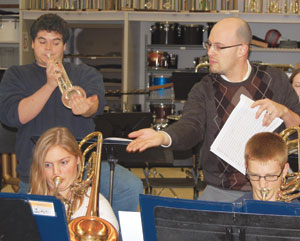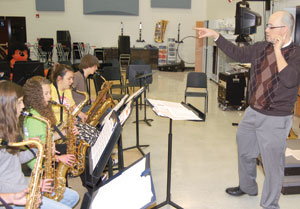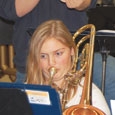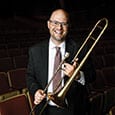 Junior high jazz groups tend to repeat some fairly common errors. Here are tips on what to watch for and how to fix them.
Junior high jazz groups tend to repeat some fairly common errors. Here are tips on what to watch for and how to fix them.
Swinging
Students who have studied for only a couple of years can have a difficult time learning the complicated feel of swing music, so some directors simply program a majority of rock tunes. Because the roots of jazz come from swing, it is important to work on this music. The difficulty lies in playing a swing tune differently from just another rock number.
In swing feel the drums should keep it simple and not play a heavy bass-snare-bass-snare backbeat. There is a lot more taste and feel in swing music than in rock. The hi-hat and ride cymbals play an essential role in swing, while the bass drum should be felt and not heard. There are plenty of jazz drummers who rarely use the bass drum except to really kick a fill. The same is true with the snare drum, which should be present but used tastefully.
In a typical Basie chart there might be just a few measures that are marked staccato. Swing lines should be smooth and connected, and composers will often place a slur over a phrase to show this. Ron Carter, jazz director at Northern Illinois University, taught me that swing comes from the fingers. You can tell if a group is swinging even if they are merely fingering the lines and not playing. By listening to the clicking of the saxophone or trumpet pads, you can hear if the notes will be placed at the right part of the beat. I might ask the saxophones to play the line without any tongue at all, making sure the swing is happening in the fingers.
Young saxophonists are especially prone to excess tonguing. When I work with a young sax section, I will often ask them to not tongue anything. When they play a line this way, then they are swinging with their fingers. It is a little more difficult to tell by the fingering if the trumpets are swinging, so I’ll have everybody listen quietly as the trumpets finger their parts. After students can finger with a swing style, have them put their horns to their faces and play. It should sound considerably smoother.
Starting to Improvise
Good jazz solos tell a story and build intensity. There is no need to start with a stream of 16 notes; it is better for a beginner to take simple ideas and expand on them. Giving the band parameters to work from at first, such as “play a solo on only the first three notes of the scale,” can give them manageable ways to start their solos. Having beginners write out and play solos, rooted in the chord changes, is another great way to get them thinking about what they are doing.
Comping
A less-is-more approach is appropriate when teaching players to comp. Students can start with one little hit, one chord per measure, and progress from one chord to simple rhythms. Maybe in some measures students don’t play at all. The more advanced groups get, the less you will hear piano and guitar behind the soloists. A more skilled pianist will listen carefully to the soloist and feel comfortable comping less. Then when they hear the soloist leave a little rest or a pause, they will fill that gap appropriately.
A great way to practice comping is with the 12-bar blues. Every student, no matter how young, can learn three chords, and memorizing the blues form should not be a problem. Horn players can practice solos and rhythm section can start listening closely and playing to accent or complement solos.
If I have multiple rhythm section players, I might assign them different charts, but also different sections in a chart. I might have piano comp the first chorus of a solo, and then have the vibes finish it out. If I have multiple guitarists, they can share a solo section the same way. This gives these students the opportunity to play off of each other’s ideas.
In some lower-grade jazz works, rhythm section parts have both chords and a suggested comping rhythm. Although this rhythm is simply a suggestion to get students started, some might play the suggested rhythm over and over. This is vamping, which is different from comping. Comping is best thought of as filling a little bit of space in a melody or solo.

Dynamics
Concert band directors do not hesitate to make changes to the parts to emphasize the melody. If a saxophone player had the melody in a concert band work, and trombones were burying it, the director might tell the trombones to write mezzo piano in to remind this section to play quieter. With jazz there is more of a temptation to let students play as loud as they can without close attention to dynamics and phrasing, which produces a cacophonous mess. When working with a group, it is important to talk through which sections have important parts. A group can sound much better if each section thinks about how it fits into the whole.
Often junior high jazz bands have way too many players. Directors understandably do not want to cut players from the band but may not have enough players for two groups. This can result in large horn sections, and the sound can easily become muddled. Even with a large ensemble it is still important to pay attention to dynamics. Students can learn about dynamics by listening to the Ellington band, the Basie band, or great college groups such as North Texas or Northern Illinois. In all of those ensembles, the various sections know when to emphasize their parts and when to play support roles. If the saxophones have an important soli part, the trumpets have to pull it back for their accompanying figures. The melody doesn’t sound as good without the accompanying lines, but the lead part should not sound muddled or overwhelmed.
Playing the Style
A jazz ensemble should play every piece with authentic style. Even if notes and rhythms are correct, the music can still sound like garbage. Every jazz director has to have a clear mental concept of how the music should sound. Directors and students both develop this concept by regularly listening to recordings. It doesn’t have to be a recording of the song you are rehearsing but something in a similar style.
I try to guide listening in class by telling students to listen for certain characteristics of the music, perhaps the use of ride cymbal or the absence of bass
drum. Guitarist Freddie Green plays with just a little bit of accent on two and four, and while that type of nuance is barely audible, if you took it away, the feel of the music would change.
It can be difficult to get junior high students to listen outside of rehearsal, so I frequently start rehearsals with listening and will have a song playing as students enter the rehearsal room. I identify the tune and make suggestions on certain things to listen for in the music. I might mention how the drummer backed up the soloists. Younger students need those specific cues to learn the most from recordings.
Over the years I have had good luck planning out the songs we are going to play in advance and giving students a CD of different jazz styles represented. I try to balance out the discs with helpful music for each section of the band and identify key elements of style for them to study, particularly with the rhythm section. I tell students that our performance might not sound exactly like the recording, but I want them to be able to approximate what they heard.
Once the first student buys into listening at home, the others will follow. I gave a trombonist a J.J. Johnson solo to listen to, and next week in rehearsal he sounded much better on his solo. I commented on his improvement and asked if he listened to the solo. When he said he had listened to it a few times, the other students got the message.
Some directors may argue that they have limited rehearsal time and cannot spend it on listening, but this is necessary if you want a group to be good and sound authentic. Even if a group only rehearses once a week, listening can work well at the beginning of class or as a break.
My high school group has one 21/2-hour rehearsal and then sectionals during the rest of the week. By the middle of the long rehearsal, the brass players are exhausted and rubbing their lips. I break up the rehearsal by taking ten minutes to show YouTube clips that illustrate how certain jazz musicians looked and sounded. Each week, the focus is on a different instrument, and I try to find clips that can teach everybody something. Students learn a great deal from watching and listening to famous players.






